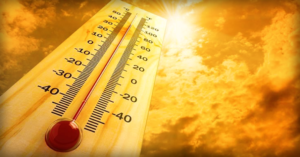Heat stress can be a major concern for outdoor workers, especially during the summer months. Working long days outside in the hot sun brings leaves landscape professionals at risk. Heat stress can result in a stroke, exhaustion, cramps or rashes. Heat rash and cramps are the mildest forms of heat stress. Heat exhaustion can occur when workers are exposed to high temperatures, especially when combined with high humidity and strenuous activity. Without treatment, heat exhaustion can lead to life-threatening heat stroke. Workers can also be at greater risk of injuries due to sweaty palms, fogged-up safety glasses and dizziness
What is heat stress?
Heat stress is the buildup in the body of heat generated by the muscles during work and from heat coming from the hot work environment. When the body is overheated, less blood flows to the brain, muscles and other organs. Because there is no pain, workers may not realize when they become weak and tired and that they are less alert and less able to use good judgement. An increase in body temperature of 2 degrees Fahrenheit can affect mental performance, and an increase in 5 degrees can cause serious illness or death.
What are the signs and symptoms or heat stress?
The signs and symptoms of heat stress include:
- Cool, moist skin with goose bumps in the heat
- Sweating
- Headache
- Fatigue
- Dry mouth, dry membranes
- No tears
- No spit present
- Muscle cramps
- Weak rapid pulse (slow if person has fainted)
- Nausea
- Dilated pupils
- Central nervous system depression
- Loss of coordination
- Confusion
How do landscape companies prevent worker heat stress concerns?
- Assign a manager for heat stress management.
- Train workers and supervisors in the prevention, recognition and treatment of heat stress, and conduct safety meetings during heat spells.
- Acclimate workers when they begin to work under hot conditions by assigning lighter work days, longer rest periods and watching workers’ response for five to seven days.
- Account for the conditions of work by checking weather conditions, how heavy the work is and if the worker has to wear additional protective wear and equipment.
- Account for the conditions of the workers by knowing if the worker has been sick, is rested, taking medications or has consumed alcohol.
- Manage work activities by setting up work breaks, rotating strenuous tasks, scheduling heavy work for cooler hours and postponing non-essential tasks during heat spells.
- Establish a drinking water program.
- Provide additional measures such as special cooling and breathable clothing, provide shade, use air-conditioned mobile equipment and modify pesticide usage to reduce the need for personal protective equipment (PPE).
- Take action and provide first aid if workers show signs and symptoms of heat stress.
How much water should workers drink?
General recommendations for workers are to drink at least one cup of water every 30 minutes and greater amounts as heat conditions become more extreme and workload level is more strenuous, even if they are not thirsty. Drinking two or three cups of water before work provides a head start, and they should continue drinking water into the evening to replace all water lost through sweating. During extreme heat or when wearing confining PPE, workers should be advised to drink a pint or more of water before beginning work. Managers should be aware of workers who have fluid retention or other medical problems that may affect the worker’s intake of fluids. Also, managers should be aware of workers who, due to economic pressure or toilet availability, tend to limit the amount of water they drink or needed breaks.
What are workload level examples?
- Light: sitting at ease, writing, sorting materials, inspecting landscapes, driving mobile equipment on paved roads.
- Moderate: using a chain saw, driving mobile equipment off-road, periodic handling of heavy materials, weeding/hoeing, pruning, backpack spraying on level-even ground, pushing or pulling light-weight carts or wheelbarrows, washing off vehicle or equipment, walking 2 to 3 mph.
- Heavy: transferring heavy materials, shoveling, digging, hand mowing, loading materials, planting, pushing or pulling loaded hand carts or wheelbarrows, laying blocks, backpack spraying on rough ground or an incline, walking 4 mph.
- Very heavy: heavy shoveling and digging, ax work, climbing stairs, ramps and ladders, lifting more than 44 pounds at 10 lifts per minute, walking, jogging or running at more than 4 mph.
How should landscape companies set work and rest periods?
Work and rest periods need to consider workload levels, air temperature, humidity, sunlight conditions, worker clothing and PPE. Workers will recover better from heat with shorter, more frequent breaks than longer, less frequent breaks. For heavier work in higher temperatures and higher humidity, longer and more frequent breaks are needed. If possible, breaks should be taken in a shaded or air conditioned area. In general, if performing heavy work at 95 degrees with 30 percent humidity, each hour of work should include a 15-minute break (45 minutes of work/15-minute break). Break times need to increase and work times need to decrease significantly as temperature and humidity increase. When air temperatures reach 105 degrees, each hour of work should include a 45-minute break (15 minutes of work/45-minute break).
